| |
|
Stations
of the Cross |
1987
H61 W50 cm |
|
|
|
|
| |
"Christ humbled himself for us, and in obedience
accepted death,
even death on a cross."
(Philippians 2.8)
|
|
|
|
|
|
|
|
The
Stations of the Cross were introduced into St Matthew's
Church in April 1987, and are situated around the
perimeter of the nave, spaced between the window
apertures of the south and north aisles in an
anti-clockwise progression.
The fourteen reliefs were modelled in clay by the
sculptor David Thomas, his first major religious
work. Thomas studied at Croydon School of Art.
After war service with the Royal Navy (Coastal Forces),
he took a degree at the Courtauld Institute, studying
the Art of the Renaissance under the late Professor
Johannes Wilde, and made prolonged visits to Italy.
He was offered a lectureship there which he held until
the mid-1950s. After some years in art administration
he returned to sculpture in 1963.
David Thomas was engaged on these Stations from
1984 when his designs were selected by competition. They
were subsequently cast by Mr D C Giles of the
British Museum. Each relief is of a resin-based
composition to simulate the colour and texture of
terracotta. The intention had been to use terracotta
itself but the material was found to be unusable for the
scale of the design Thomas felt St Matthew's proportions
required. The 14 Stations of the Cross, which depict the
events of the final journey of Christ from trial before
Pilate to burial, warm considerably the appearance of
the nave.
A further example of Thomas’ work may be found in
West Sussex where he subsequently designed and modelled
the scene of Christ's Resurrection cast in bronze for
the tympanum of the Romanesque Church.
Things to look out for:
Notice the sculptor’s dramatic use of relief to draw the
eye and help the viewer distinguish the more important
aspects first. Also for dramatic purposes the sculptor
has throughout the series in various ways distorted
normal bodily proportions.
Jesus falls three times whilst carrying his cross. Each
time the fall is heavier than before. Notice the
apparent ‘rotation’ of the cross with each fall to the
point where the right way up is not clear signifying,
perhaps, growing disorientation. At Station IX – ‘Jesus
Falls the Third Time’, notice the contortion of Jesus’
body.
The following brief meditations may be found helpful:
|
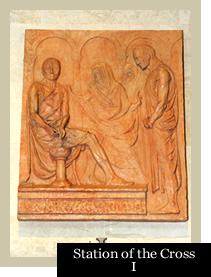 |
|
Station I |
|
Jesus is Condemned to
Death |
| |
|
Two different kinds of power face each
other. Pilate could find no fault in Jesus,
but handed him over to the people – a weak
and fearful ruler swayed by a violent crowd.
On one level it made little difference to
Pilate whether one Jew lived or died, and it
enabled him to obtain from the crowd the
useful affirmation that they had no King but
Caesar. Yet, he sensed that Jesus was
unique, and washed his hands in a vain
attempt to wash away his part in Christ’s
death. |
| |
|
|
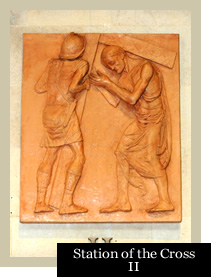 |
|
Station II |
|
Jesus Takes Up
the Cross |
| |
|
The slow procession to the place of
execution began, and Jesus, though weak from
continuous questioning, mocking and beating,
was made to carry his own cross. He was led
away as a common criminal to suffer one of
the most degrading forms of execution ever
invented. But the burden that Jesus had to
carry was much greater than the physical
weight of the cross, for he also had to
carry the sins of us all. |
| |
|
|
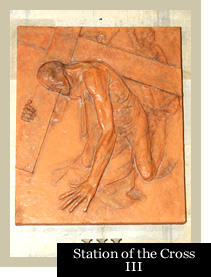 |
|
Station III |
|
Jesus Falls the
First Time |
| |
|
Weakened by the unbearable torments that he
had already gone through, the added weight
of the cross was too much for Jesus, and he
fell. As he knelt there the cry of anguish
that he was later to utter cannot have been
far from his lips, "My God, my God, why have
you forsaken me?" We sometimes feel alone:
that God has forsaken us and does not answer
our prayers. But we, like Jesus, must know
in our hearts that however far away God
seems to be, he never forsakes us – he is
always faithful. |
| |
|
|
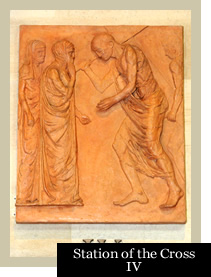 |
|
Station IV |
|
Jesus Meets
His Blessed Mother |
| |
|
Mary had brought up her son through many
hardships, and cared for him as a loving
mother. Her appearance is beyond her years.
Now she saw him, barely recognizable except
to her eyes, being led to his death at
little over thirty years of age. Was this
really what he had meant when he said, “Did
you not know that I must be busy with my
Father’s affairs?” Certainly this was the
sword that the old man Simeon had predicted
would pierce her soul.
But Mary, unlike most of the disciples, did
not desert her son in his time of greatest
need, but stood by him to the end. Let us
ask that we too may have a faith like Mary,
to stand by Jesus whatever the cost. |
| |
|
|
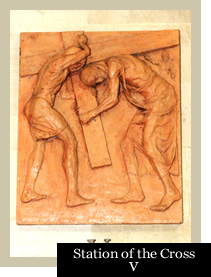 |
|
Station V |
|
Simon of
Cyrene helps Carry the Cross |
| |
|
Jesus was so weak that the soldiers were
afraid that he may not reach the place of
execution, so they forced a passer-by, a
complete stranger, to carry his cross. Simon
no doubt tried to refuse, but in the end did
carry the cross.
Only the day before, the disciples had
insisted that they would remain faithful to
Jesus whatever happened, but first they fell
asleep in the garden, and then after the
arrest they ran away. How like the parable
that Jesus had told, where it was the
unwilling son who in fact did what his
father wanted. Words and empty promises are
not enough. We, like Simon, must take up our
cross and share in Christ’s passion in our
daily lives. |
| |
|
|
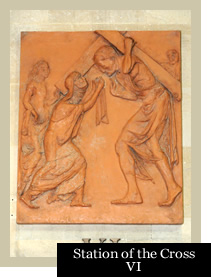 |
|
Station VI |
|
Veronica Wipes
the Face of Jesus |
| |
|
In a great act of kindness a woman stepped
forward from the crowd and wiped the
bloodstained face of Jesus. A few days
earlier another woman had anointed Jesus
with costly perfume. A few hours later a man
would give Jesus his tomb. All of these were
acts of love and charity to the Lord. And we
can perform similar acts of charity to
Jesus, living now in our brothers and
sisters in need. For whatever we do to help
one another we do it for Jesus. |
| |
|
|
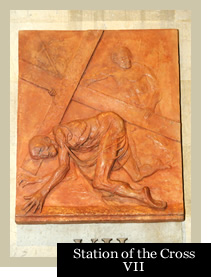 |
|
Station VII |
|
Jesus Falls
the Second Time |
| |
|
A little further along the road Jesus
stumbled and fell again. He must have felt
so utterly exhausted and desolate that he
could not possibly go any further. But he
had to go on to fulfill his Father’s will,
and so again he struggled to his feet and
carried on. Sometimes we too feel that
things are hopeless; that we cannot go on.
But we too have God’s work to do, and we too
must continue with trust and faith in the
power of Jesus working in us. |
| |
|
|
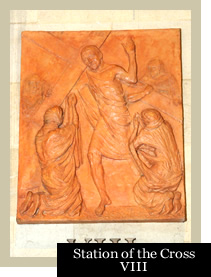 |
|
Station VIII |
|
Jesus Speaks
to the Women of Jerusalem |
| |
|
Some pious women began to weep for Jesus,
and tried to console him, but he told them
not to weep for him, but for themselves and
for their children. Jesus was in agony, and
yet he refused their consolation, not
through ingratitude, but because he knew the
agony that they and others would suffer
because of their rejection of him. When we
feel rejected or badly treated, we must
remember this example of Jesus. We must
still remember others who are suffering,
perhaps more than we are, and who need our
help and compassion, and not let ourselves
become caught up in self-pity. |
| |
|
|
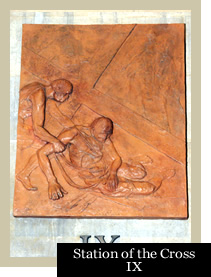 |
|
Station IX |
|
Jesus Falls
the Third Time |
| |
|
Three times Jesus resisted the temptations
of Satan in the wilderness. Three times
Peter denied he knew Jesus. Three times
Jesus fell to the ground on the way to
Calvary.
Just as Jesus forgave Peter even that
threefold denial, so he will forgive us if
we turn to him in penitence. No sin is too
great for Jesus to forgive, so long as we
are truly sorry, and are prepared to rely on
his love and forgiveness rather than on our
own efforts.
Even after this third and heaviest fall,
Jesus once again struggled to his feet and
continued. And so must we – even in the
moment of our greatest fall we must not
lose hope, but get up and continue with
faith in our Lord’s merciful love. |
| |
|
|
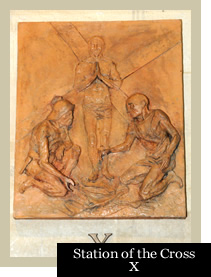 |
|
Station X |
|
Jesus is
Stripped of His Garments |
| |
|
The journey was over – they had arrived at
last at the place of execution. First they
stripped Jesus of his clothing, and so he
ended his life as he had begun it – with
nothing.
We have clothing and enough food, and many
other comforts which we rightly enjoy, but
we must not become so involved with the
things of this world that we lose sight of
what really matters. We must keep our sight
firmly fixed on God, and be ready to share
what we have, and ready to accept whatever
comes to us in his name – even being left
with nothing.
|
| |
|
|
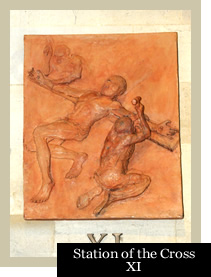 |
|
Station XI |
|
Jesus is
Nailed to the Cross |
| |
|
Jesus stretched out his arms on the cross in
a gesture of forgiveness for the whole
world.
Before he died, he had time for two further
particular acts of forgiveness. First, he
forgave his executioners even as they
hammered in the nails; then he forgave the
penitent thief who was crucified with him.
Just as Jesus forgave them, so he always
forgives us when we sin; and so also must we
forgive others who wrong us.
|
| |
|
|
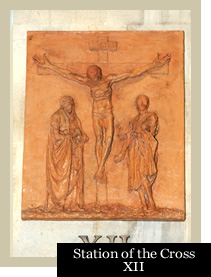 |
|
Station XII |
|
Jesus Dies on
the Cross |
| |
|
Jesus hung on the cross for only a short
time – the mental and physical torments he
had suffered had taken all his strength. He
commended his spirit to his Father and died.
It was all over…
But of course, it was not all over – it was
only the beginning. Christ had to die so
that we could live. As the soldier pierced
his side, out flowed the blood and water
that was to seal the new and everlasting
covenant between God and the world.
|
| |
|
|
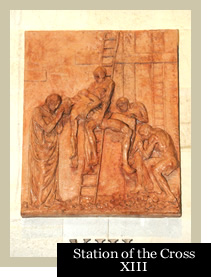 |
|
Station XIII |
|
Jesus is Taken
Down from the Cross |
| |
|
Jesus hung dead on the cross, and so now did
the two thieves. The crowds had gone home.
The soldiers, their duty done, had left.
Silence descended upon Calvary.
The body of Jesus was carefully taken down
from the cross and laid in Mary’s arms. Now
she carried her son’s lifeless body in her
arms, as once she had carried his unborn
body in her womb, for this death was the
prelude to new life.
|
| |
|
|
 |
|
Station XIV |
|
Jesus is Laid
in the Tomb |
| |
|
The body of Jesus is prepared for burial as
was the custom and placed in the tomb. But
not even the power of death could hold him.
Christ had to die and be buried before he
could rise again. In the same way, we too
have to die and be buried with Christ in the
waters of baptism, so that we too rise again
to new life with him.
Ours is the task to try to live that risen
life here on earth, so that when our time
comes to die, we may pass through the gates
of death to new and everlasting life with
Jesus.
|
|
|
|
|









